Innocenti Report Card
In keeping with UNICEF's mandate to advocate for children in every country, the Centre's Report Card series focuses on the well-being of children in industrialized countries. Each Report Card includes a league table ranking the countries of the OECD according to their record on the subject under discussion. The Report Cards are designed to appeal to a wider audience while maintaining academic rigour.

Child Well-Being in an Unpredictable World
Growing up in a wealthy country with abundant resources does not a guarantee a happy, healthy childhood. Since the start of the COVID-19 pandemic, children in some of the richest countries experienced significant declines in their academic performance, mental well-being and physical health. These troubling trends threaten to undermine the future potential and overall well-being of children. The latest Innocenti Report Card 19 from UNICEF’s Global Office of Research and Foresight answers three core questions: How have children fared in the face of a rapidly changing and often unpredictable global environment? What are the key factors affecting children’s lives? What can be done to promote child well-being?

Child Poverty in the Midst of Wealth
In a time of general prosperity, more than 69 million children live in poverty in some of the world’s richest countries. Poverty is often defined by income. But for most children, poverty is about more than just money. It is about growing up in a home without enough heat or nutritious food. Poverty means no new clothes, no telephone and no money for a birthday celebration. For the eighteenth edition of the Innocenti Report Card, UNICEF Innocenti examined child poverty in the high-income and upper middle-income countries in the European Union (EU) and the Organisation for Economic Co-operation and Development (OECD). This Report Card provides an assessment of the current state of child poverty and the progress – or lack of progress – that these countries made towards eliminating it.
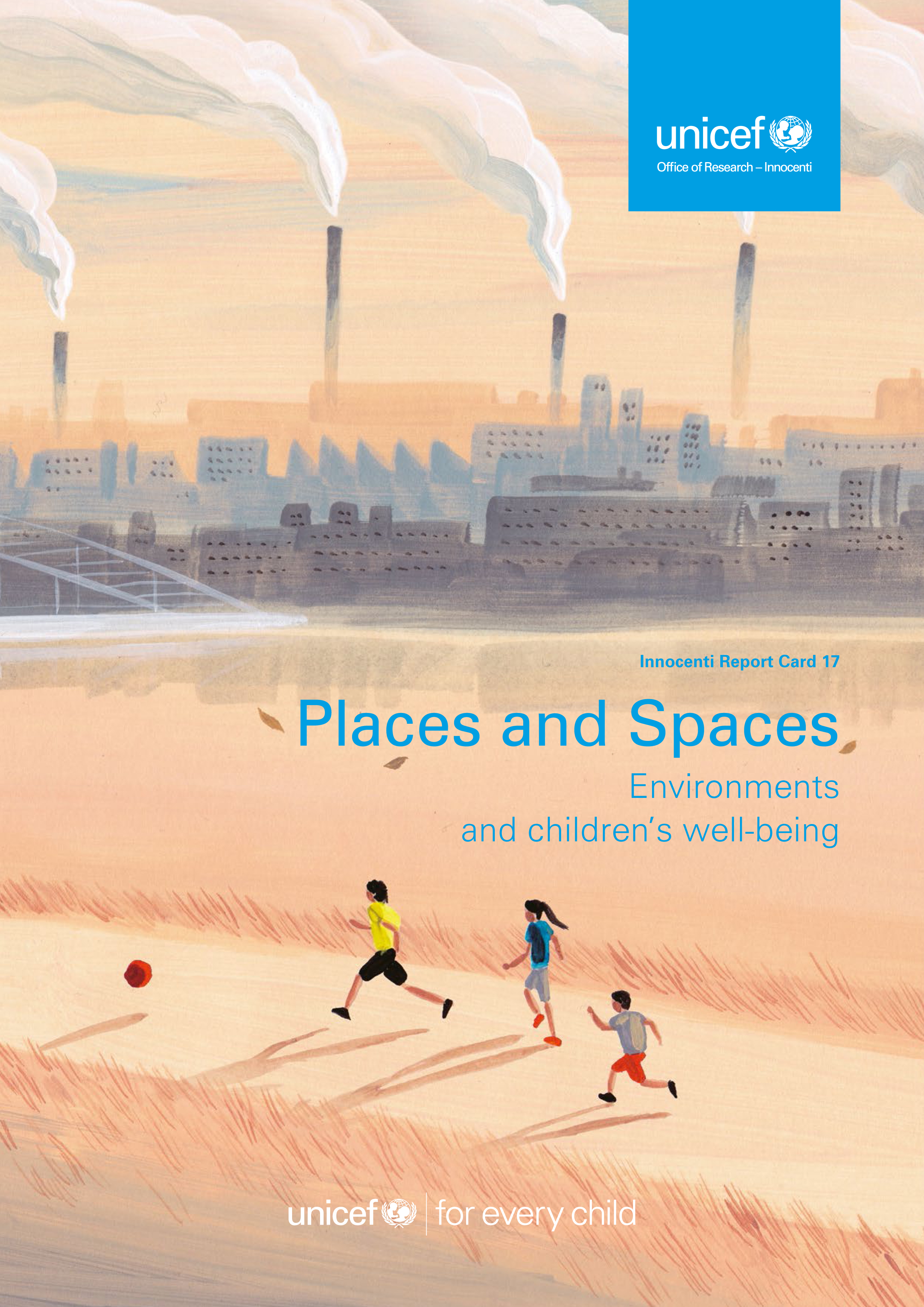
Places and Spaces
Environments and Children's Well-being
Report Card 17 explores how 43 OECD/EU countries are faring in providing healthy environments for children. Do children have clean water to drink? Do they have good-quality air to breathe? Are their homes free of lead and mould? How many children live in overcrowded homes? How many have access to green play spaces, safe from road traffic? Data show that a nation’s wealth does not guarantee a healthy environment. Far too many children are deprived of a healthy home, irreversibly damaging their current and future well-being. Beyond children’s immediate environments, over-consumption in some of the world’s richest countries is destroying children’s environments globally. This threatens both children worldwide and future generations. To provide all children with safe and healthy environments, governments, policymakers, businesses and all stakeholders are called to act on a set of policy recommendations.
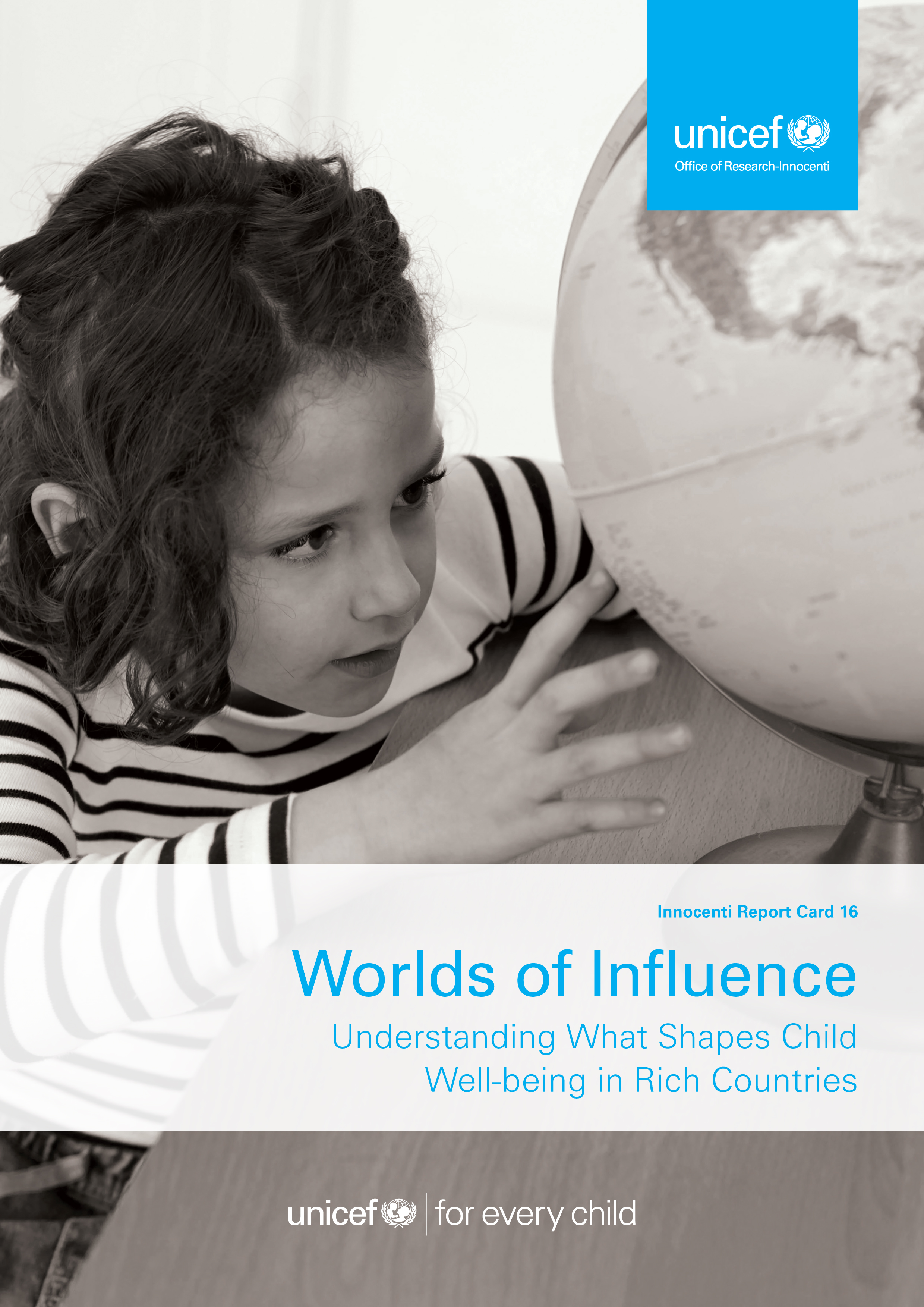
Worlds of Influence
Understanding What Shapes Child Well-being in Rich Countries
For the last 20 years, the Innocenti Report Card series has led the way in comparing children’s well-being across rich countries. Report Card 16 develops this further through a multi-level approach to show that children’s well-being is influenced by children’s own actions and relationships, by the networks and resources of their caregivers, and by public policies and the national context. This approach is aligned with the 1989 United Nations Convention on the Rights of the Child, in that it recognizes the responsibilities of governments, families and communities to help realize children’s rights and promote their well-being.
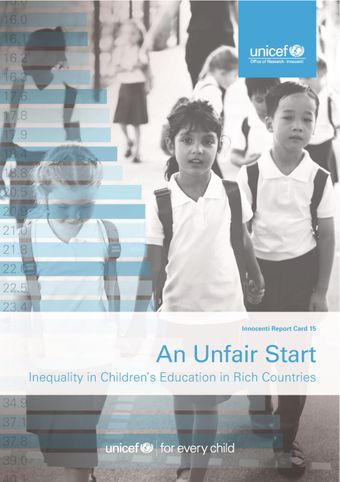
An Unfair Start
Inequality in Children’s Education in Rich Countries
This report focuses on educational inequalities in 41 of the world’s richest countries, all of which are members of the Organisation for Economic Co-operation and Development (OECD) and/or the European Union (EU). Using the most recent data available, it examines inequalities across childhood -- from access to preschool to expectations of post-secondary education - and explores in depth the relationships between educational inequality and factors such as parents’ occupations, migration background, the child’s gender and school characteristics. The key feature of the report is the league table, which summarizes the extent of educational inequalities at preschool, primary school and secondary school levels.
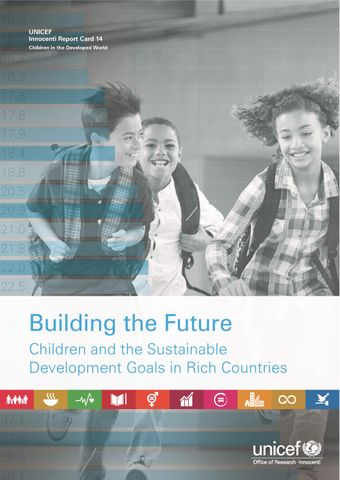
Building the Future
Children and the Sustainable Development Goals in Rich Countries
The Sustainable Development Goals (SDGs) agreed by the international community in 2015 represent an ambitious effort to set a global agenda for development that is both equitable and sustainable, in social, economic and environmental terms. The earlier Millennium Development Goals (MDGs) prioritized the reduction of poverty, as well as progress in related social indicators. The 17 goals of the SDGs add to this a series of outcomes associated with inequality, economic development, the environment and climate change, as well as peace and security. In contrast to the MDGs, which primarily applied to low- and middle-income countries, the ambitious agenda of the SDGs is of necessity universal; it thus applies to rich countries, as well as poor.
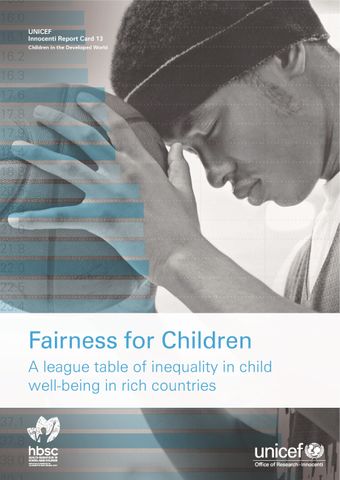
Fairness for Children
A League Table of Inequality in Child Well-being in Rich Countries
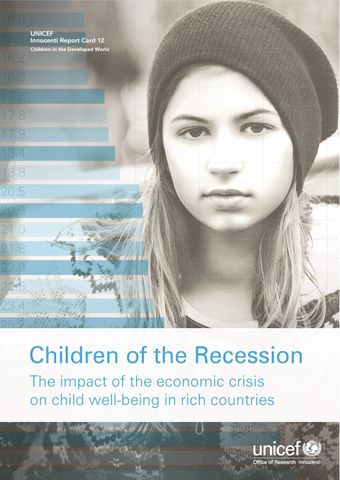
Children of the Recession
The Impact of the Economic Crisis on Child well-being in Rich Countries

Child well-being in Rich Countries
A Comparative Overview
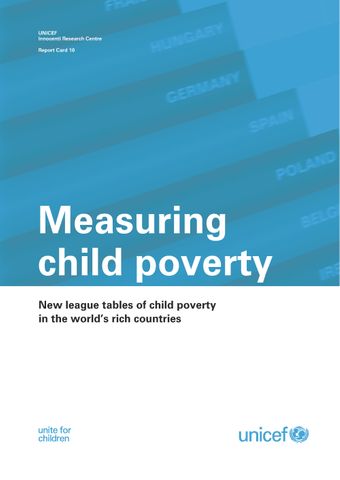
Measuring Child Poverty
New League Tables of Child Poverty in the World’s Rich Countries
The United Nations Children’s Fund (UNICEF) - Innocenti Research Centre Report Card series provokes debate on child well-being in wealthy countries. It provides an important tool to address critical issues affecting disadvantaged children in the industrialized world. Since 2000, the Centre has released nine issues of the series, each addressing different aspects of the living conditions of children and adolescents. All the Report Cards are built around a league table, ranking countries according to their performance on a key child indicator or group of indicators. This issue investigates poverty and vulnerability among children in rich countries.
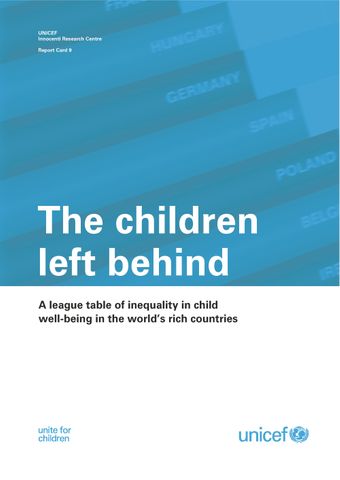
The Children Left Behind
A League Table of Inequality in Child Well-Being in the World’s Rich Countries
Report Card 9 The Children Left Behind presents a first overview of inequalities in child well-being for 24 Member States of the Organisation for Economic Cooperation and Development. The Report Card focuses on the relative gap between children in the bottom of the distribution with those occupying the median. Three dimensions of well-being are examined: material, education, and health. In each case, the questions asked are: how far behind children are being allowed to fall, and why some countries are doing so much better at protecting their most vulnerable children.
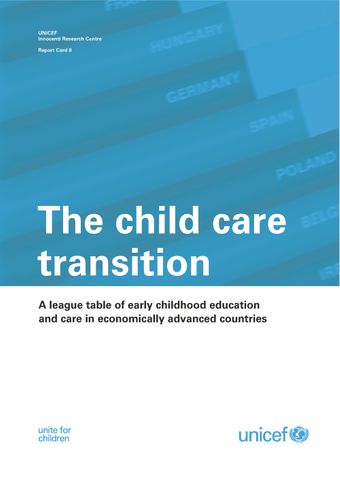
The Child Care Transition
A League Table of Early Childhood Education and Care in Economically Advanced Countries
A great change is coming over childhood in the world’s richest countries. Today’s rising generation is the first in which a majority are spending a large part of early childhood in some form of out-of-home child care. At the same time, neuroscientific research is demonstrating that loving, stable, secure, and stimulating relationships with caregivers in the earliest months and years of life are critical for every aspect of a child’s development. Taken together, these two developments confront public and policymakers in countries of the Organisation for Economic Co-operation and Development (OECD) with urgent questions. Whether the child care transition will represent an advance or a setback for today’s children and tomorrow’s world, will depend on the response.
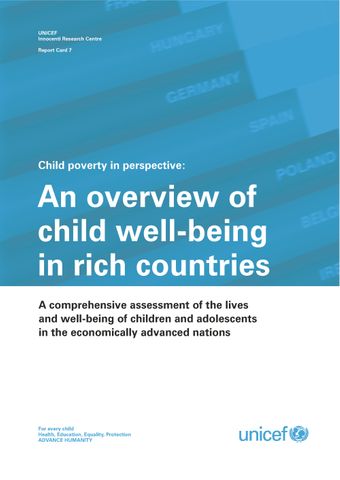
Child Poverty in Perspective
An Overview of Child Well-Being in Rich Countries - A Comprehensive Assessment of the Lives and Well-Being of Children and Adolescents in the Economically Advanced Nations
This Report Card provides a comprehensive assessment of the lives and well-being of children and young people in 21 nations of the industrialized world. Its purpose is to encourage monitoring, to permit comparison, and to stimulate the discussion and development of policies to improve children’s lives. It is the seventh in a series of Innocenti Report Cards, designed to monitor and compare the performance of the OECD countries in securing the rights of their children.
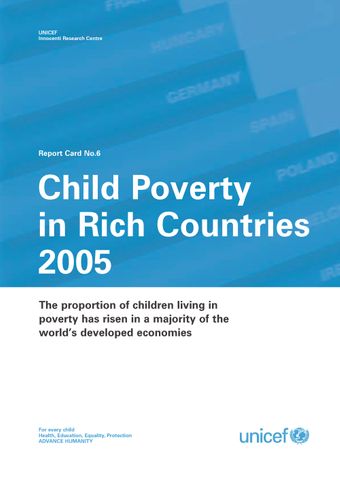
Child Poverty in Rich Countries 2005
The Proportion of Children Living in Poverty has Risen in a Majority of the World’s Developed Economies
This Review finds that the proportion of children living in poverty has risen in a majority of the world’s developed economies for which data are available. No matter which of the commonly-used poverty measures is applied, the situation of children is seen to have deteriorated over the last decade. Allowing the kind of poverty that denies a child the opportunities that most children consider normal is a breach of the United Nations Convention on the Rights of the Child. Reducing child poverty is also a measure of progress towards social cohesion, equality of opportunity, and investment in both today’s children and tomorrow’s world.
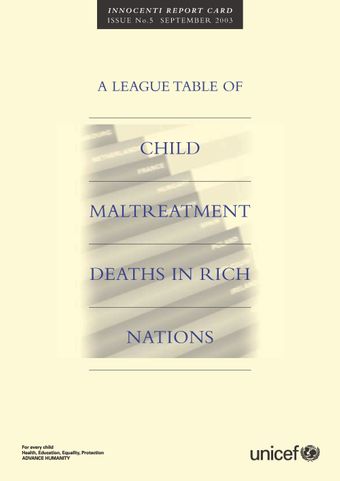
A League Table of Child Maltreatment Deaths in Rich Nations
This publication is the fifth in a series of Innocenti Report Cards designed to monitor the performance of industrialized nations in meeting the needs of their children. Each Report Card presents and analyzes league tables ranking the performance of rich nations against critical indicators of child well being. This particular report presents the league table of child maltreatment deaths in rich nations and discusses related issues.
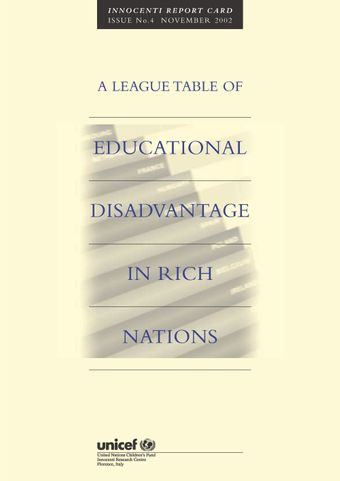
A League Table of Educational Disadvantage in Rich Nations
This publication monitors the performance of industrialized countries in meeting the needs of their children. Using data from two different surveys of students in twenty-four OECD countries, it presents the big picture of how well each country’s educational system is performing when measured by (a) what portion of students fall below given benchmarks of educational achievement and (b) at what point the lowest achieving pupils fall behind the national average.In addition, the publication analyzes league tables ranking the performance of rich nations against critical indicators of child well-being and discusses similarities between educational outcomes across OECD countries.
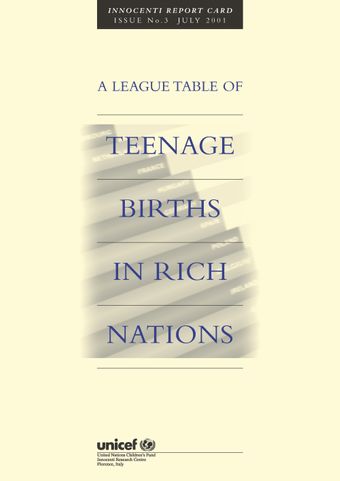
A League Table of Teenage Births in Rich Nations
This publication presents the most up-to-date and comprehensive survey on teenage birth rates in the industrialized world. It attempts to analyze why some countries have teenage birth rates that are as much as ten or even fifteen times higher than others.
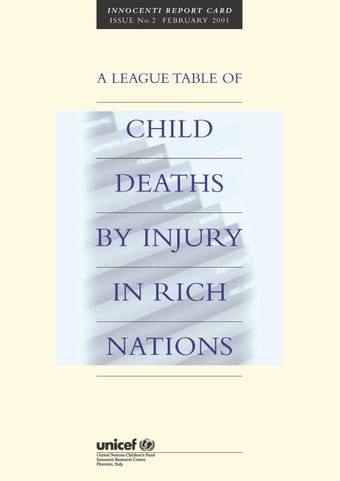
A League Table of Child Deaths by Injury in Rich Nations
This second Innocenti Report Card focuses on child death by injury in the member countries of the OECD. It presents, for the first time, a standardized league table ranking 26 of the world’s richest nations according to their injury death rates for children aged 1 to 14. Even though child injury death rates have been falling for more than two decades, it would be wrong to conclude that the problem is simply going away. International comparisons in this publication dramatically demonstrate that most countries still have a long way to go. It is hoped that this report will be a cause for a policy change leading to further reductions in child injuries.
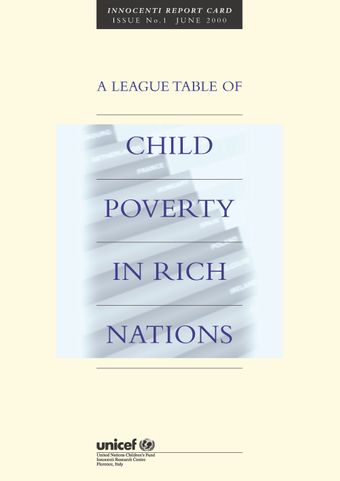
A League Table of Child Poverty in Rich Nations
This publication provides the most comprehensive estimates so far of child poverty across the 23 member countries of the Organization for Economic Cooperation and Development (OECD), the world’s wealthiest nations. It highlights the fact that despite a doubling of national incomes in most OECD nations since 1950, a significant percentage of their children are still living in families so materially poor that normal health and growth are at risk. By comparing data from different countries, the publication asks what can be learned about the causes of child poverty and examines the policies that have contributed to the success of lower rates in some countries. In particular, it seeks to explain the situation by exploring the impact on poverty rates of single parenthood, unemployment, low wages and levels of social expenditures. This publication is the first in a series of Innocenti Report Cards on the situation of children in industrialized countries.
